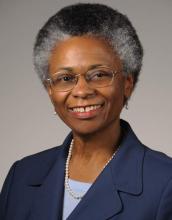
October, 2020
DR. BERNARD'S REFLECTIONS

Marie A. Bernard, MD
Acting Chief Officer for Scientific Workforce Diversity
The COVID-19 pandemic continues to impact the lives of the public and the scientific workforce. In May, this office covered a variety of topics related to the Diversity, Equity, Inclusion and COVID-19. Today, we are highlighting updated findings related to COVID’s disproportionate effects on underserved populations—many of whom are underrepresented in the sciences and medicine. We will also highlight NIH’s recent efforts to address the pandemic. Although the extent of the pandemic’s effects may take years to fully come to light, if we remain persistent, continue to strive for inclusive excellence, and rely on scientific principles, we can do our best to protect the recent gains made in diversifying the scientific community
COVID-19 & Vulnerable Populations
As the third wave of COVID-19 begins to rise in the United States, the virus continues to shine a light on the health disparities among underserved and vulnerable groups. News reports have highlighted the disproportionate racial disparities noted in COVID-19 infection rates and related deaths in African American, Hispanic and Latino, and Native Alaskan communities, that have persisted and, in some cases, worsened since May. To effectively tackle these issues, we need rigorous tracking of COVID-related metrics by race and ethnicity, culturally sensitive messaging, and comprehensive strategies that inspire inclusion. To this end, NIH has initiated a couple of programs worthy of notice. To ameliorate testing access issues for vulnerable groups, the NIH has made strides to expand COVID-19 testing through the RADx-UP program—which aims to develop strategies that reduce disparities in COVID-19 testing to increase access to underserved groups. NIH also launched the CEAL initiative that aims to remove barriers to underrepresented groups participating in and benefiting from COVID research.
Recent Impacts on The Scientific Workforce
While biomedical researchers examine ways to address COVID-19’s effects on individuals and communities, the pandemic is conversely affecting them in a number of ways. Academic jobs can be scarce during standard times, but this year some outlets are reporting faculty job openings at U.S. institutions are down 70% compared to last year. This could have a tremendous effect on the transition of postdocs into academic science positions. Recent publications have also suggested there are unequal effects of the COVID-10 pandemic on scientists—particularly on female scientists, ‘bench scientists’, and researchers with young children who experienced a substantial decline in time devoted to research. The potentially compounding effects this may have on populations underrepresented in the biomedical workforce is unclear. To establish a firmer understanding of the pandemic’s effects on the scientific workforce, the NIH has been conducting studies to uncover potentially vulnerable populations and novel issues within the workforce at NIH and NIH-funded institutions, which you will learn more about in the next section.
Addressing Challenges Through Current Efforts
Amidst the pandemic, the NIH has moved to address several issues related to the pandemic. The NIH Workforce COVID-19 Impact Survey was conducted by our office, in conjunction with other NIH offices, to assess the impact of the pandemic on the NIH internal workforce. The data are being examined and will guide policy changes to support the NIH workforce. In addition, under our office’s leadership, NIH is fielding surveys to assess the pandemic’s impact on the scientific workforce at NIH-funded institutions. The results may inform evidence-based implementation strategies to address issues related to the pandemic. The NIH is also launching the Faculty Institutional Recruitment Sustainable Transformation program (FIRST) to create cultures of inclusive excellence by establishing a faculty cohort-model for hiring at NIH-funded institutions. Lastly, although the flexibilities for grant recipients to charge salaries and benefits to active NIH awards under unexpected or extraordinary circumstances has ended, requests will still be considered on a case by case basis.

The links above are pulled from the top news articles trending on the subject of diversity in science and technology.
The stories selected are not a reflection of the views of the National Institutes of Health.

